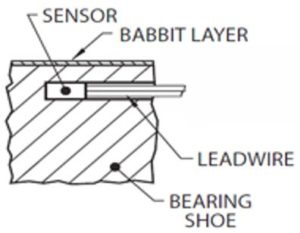Measure the Cause, Not the Symptom
 Directly measuring bearing metal temperature is the most effective way to really determine if a bearing is running hot. Bearing oil drain temperatures are still being utilized on older machines. By the time the bearing oil drain temperature has increased, the bearing may have already been compromised (wiped). PSG recommends that these older machines should have temperature probes (thermocouples or RTD’s) installed in the bearing Babbitt to properly monitor performance. A two-level alarm is recommended (not automatic trip). The first alarm should be set a few degrees above the highest temperature in the recommended normal operating range. Operators should closely monitor bearing temperature after the first alarm sounds. If the temperature rises abruptly and unexpectedly, the bearing may have been compromised and immediate action needs to be taken. Gradual temperature changes which trigger the alarm may be the result of other factors but are still a concern and should be thoroughly investigated. The second alarm should be set at the maximum operating temperature of the bearing material. Operators should manually trip the unit in a controlled manner as soon as possible after this second alarm sounds and determine the cause. The critical temperatures for each of the two levels can be supplied by the manufacturer or recommended by PSG for your individual unit configuration. Different temperature ranges are recommended for Tilt Pad, Elliptical, Short Elliptical and Thrust bearings. Measuring drain oil temperature is too slow and too imprecise to effectively minimize your overall cost of maintenance. Retrofit your machine and save your bottom line.
Directly measuring bearing metal temperature is the most effective way to really determine if a bearing is running hot. Bearing oil drain temperatures are still being utilized on older machines. By the time the bearing oil drain temperature has increased, the bearing may have already been compromised (wiped). PSG recommends that these older machines should have temperature probes (thermocouples or RTD’s) installed in the bearing Babbitt to properly monitor performance. A two-level alarm is recommended (not automatic trip). The first alarm should be set a few degrees above the highest temperature in the recommended normal operating range. Operators should closely monitor bearing temperature after the first alarm sounds. If the temperature rises abruptly and unexpectedly, the bearing may have been compromised and immediate action needs to be taken. Gradual temperature changes which trigger the alarm may be the result of other factors but are still a concern and should be thoroughly investigated. The second alarm should be set at the maximum operating temperature of the bearing material. Operators should manually trip the unit in a controlled manner as soon as possible after this second alarm sounds and determine the cause. The critical temperatures for each of the two levels can be supplied by the manufacturer or recommended by PSG for your individual unit configuration. Different temperature ranges are recommended for Tilt Pad, Elliptical, Short Elliptical and Thrust bearings. Measuring drain oil temperature is too slow and too imprecise to effectively minimize your overall cost of maintenance. Retrofit your machine and save your bottom line.
